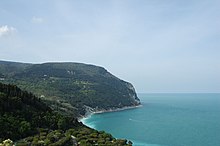
Rambutan is a medium-sized tropical tree in the family Sapindaceae. The name also refers to the edible fruit produced by this tree. The rambutan is native to Southeast Asia. It is closely related to several other edible tropical fruits, including the lychee, longan, pulasan, and quenepa.

Prunus is a genus of trees and shrubs in the flowering plant family Rosaceae that includes plums, cherries, peaches, nectarines, apricots, and almonds. The genus has a cosmopolitan distribution, being native to the North American temperate regions, the neotropics of South America, and temperate and tropical regions of Asia and Africa, There are 340 accepted species. Many members of the genus are widely cultivated for their fruit and for decorative purposes. Prunus fruit are drupes, or stone fruits. The fleshy mesocarp surrounding the endocarp is edible while the endocarp itself forms a hard, inedible shell called the pyrena. This shell encloses the seed, which is edible in some species, but poisonous in many others. Besides being eaten off the hand, most Prunus fruit are also commonly used in processing, such as jam production, canning, drying, and the seeds for roasting.

Morus, a genus of flowering plants in the family Moraceae, consists of diverse species of deciduous trees commonly known as mulberries, growing wild and under cultivation in many temperate world regions. Generally, the genus has 64 subordinate taxa, three of which are well-known and are ostensibly named for the fruit color of the best-known cultivar: white, red, and black mulberry, with numerous cultivars and some taxa currently unchecked and awaiting taxonomic scrutiny. M. alba is native to South Asia, but is widely distributed across Europe, Southern Africa, South America, and North America. M. alba is also the species most preferred by the silkworm, and is regarded as an invasive species in Brazil and the United States.

Castanea sativa, the sweet chestnut, Spanish chestnut or just chestnut, is a species of tree in the family Fagaceae, native to Southern Europe and Asia Minor, and widely cultivated throughout the temperate world. A substantial, long-lived deciduous tree, it produces an edible seed, the chestnut, which has been used in cooking since ancient times.

Arbutus is a genus of 12 accepted species of flowering plants in the family Ericaceae, native to temperate regions of the Mediterranean, western Europe, the Canary Islands and North America, and commonly called madrones or strawberry trees. The name Arbutus was taken by taxonomists from Latin, where it referred to the species now designated Arbutus unedo.

Mespilus germanica, known as the medlar or common medlar, is a large shrub or small tree in the rose family Rosaceae. The fruit of this tree, also called medlar, has been cultivated since Roman times, is usually available in winter and eaten when bletted. It may be eaten raw and in a range of cooked dishes. When the genus Mespilus is included in the genus Crataegus, the correct name for this species is Crataegus germanica (Kuntze). In the southwest of England it historically had a number of vulgar nicknames, such as open-arse and monkey's bottom, due to the appearance of its large calyx.
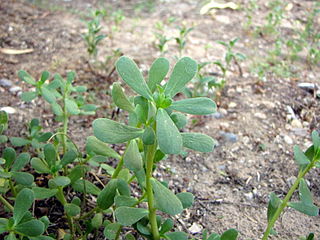
Portulaca oleracea is an annual succulent in the family Portulacaceae.

The açaí palm, Euterpe oleracea, is a species of palm tree (Arecaceae) cultivated for its fruit, hearts of palm, leaves, and trunk wood. Global demand for the fruit has expanded rapidly in the 21st century, and the tree is cultivated for that purpose primarily.

Myrica rubra, also called yangmei, yamamomo, Chinese bayberry, red bayberry, yumberry, waxberry, or Chinese strawberry is a subtropical tree grown for its fruit.

Morus rubra, commonly known as the red mulberry, is a species of mulberry native to eastern and central North America. It is found from Ontario, Minnesota, and Vermont south to southern Florida, and west as far as southeastern South Dakota, Nebraska, Kansas, and central Texas. There have been reports of isolated populations in New Mexico, Idaho, and British Columbia.
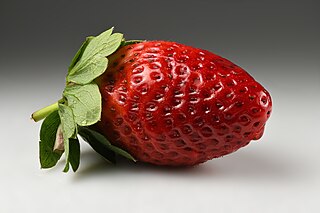
The garden strawberry is a widely grown hybrid species of the genus Fragaria, collectively known as the strawberries, which are cultivated worldwide for their fruit. The fruit is widely appreciated for its characteristic aroma, bright red color, juicy texture, and sweetness. It is consumed in large quantities, either fresh or in such prepared foods as jam, juice, pies, ice cream, milkshakes, and chocolates. Artificial strawberry flavorings and aromas are also widely used in products such as candy, soap, lip gloss, perfume, and many others.

Opuntia ficus-indica, the Indian fig opuntia, fig opuntia, or prickly pear, is a species of cactus that has long been a domesticated crop plant grown in agricultural economies throughout arid and semiarid parts of the world. O. ficus-indica is the most widespread and most commercially important cactus. It is grown primarily as a fruit crop, and also for the vegetable nopales and other uses. Cacti are good crops for dry areas because they efficiently convert water into biomass. O. ficus-indica, as the most widespread of the long-domesticated cactuses, is as economically important as maize and blue agave in Mexico. Opuntia species hybridize easily, but the wild origin of O. ficus-indica is likely to have been in central Mexico, where its closest genetic relatives are found.

Homogentisic acid is a phenolic acid usually found in Arbutus unedo (strawberry-tree) honey. It is also present in the bacterial plant pathogen Xanthomonas campestris pv. phaseoli as well as in the yeast Yarrowia lipolytica where it is associated with the production of brown pigments. It is oxidatively dimerised to form hipposudoric acid, one of the main constituents of the 'blood sweat' of hippopotamuses.

Muntingia is a genus of plants in the family Muntingiaceae, comprising only one species, Muntingia calabura, and was named in honour of Abraham Munting. It is native to the Neotropics, from Mexico south to Bolivia and Argentina, with edible fruit, and has been widely introduced in other tropical areas.
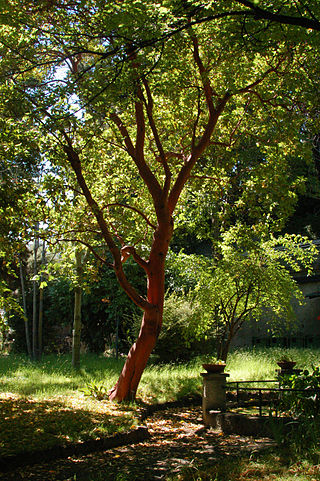
Arbutus andrachne, commonly called the Greek strawberry tree, is an evergreen shrub or small tree in the family Ericaceae, native to the Mediterranean region and the Middle East.

Arbutus canariensis, known in Spanish as madroño canario, is a species of shrub or tree in the heath family. It is endemic to the Canary Islands of Spain, specifically Tenerife, La Gomera, Gran Canaria, El Hierro, and La Palma. It is threatened by habitat loss.
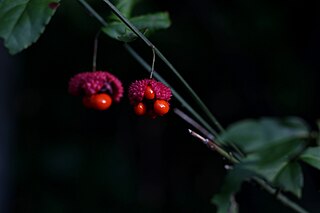
Euonymus americanus is a species of flowering plant in the family Celastraceae. Common names include strawberry bush, American strawberry bush, bursting-heart, hearts-a-bustin, and hearts-bustin'-with-love. It is native to the eastern United States, its distribution extending as far west as Texas. It has also been recorded in Ontario.

Rhus copallinum, the winged sumac, shining sumac, dwarf sumac or flameleaf sumac, is a species of flowering plant in the cashew family (Anacardiaceae) that is native to eastern North America. It is a deciduous tree growing to 3.5–5.5 metres (11–18 ft) tall and an equal spread with a rounded crown. A 5-year-old sapling will stand about 2.5 metres (8.2 ft).
Strawberry tree is a common name for:

Arbutus × andrachnoides, the hybrid strawberry-tree, is the result of a cross between Arbutus andrachne and Arbutus unedo. It is a naturally occurring hybrid, but hybrid cultivars have also been created. It has gained the RHS's Award of Garden Merit.












